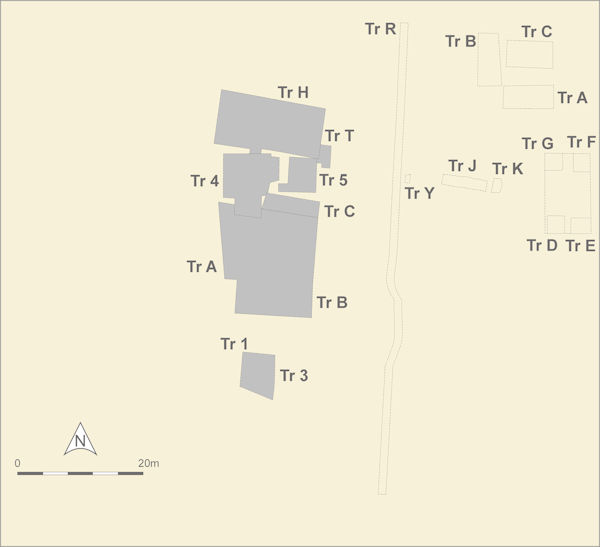

During this phase, which ended with demolition of the friary around 1560, the friary Church and West Range continued to thrive. Cobbled surfaces were laid around the external areas to the north and west of the church. Mortar floors were laid and a partition wall constructed within the church. A small number of burials took place inside and to the north of the church.
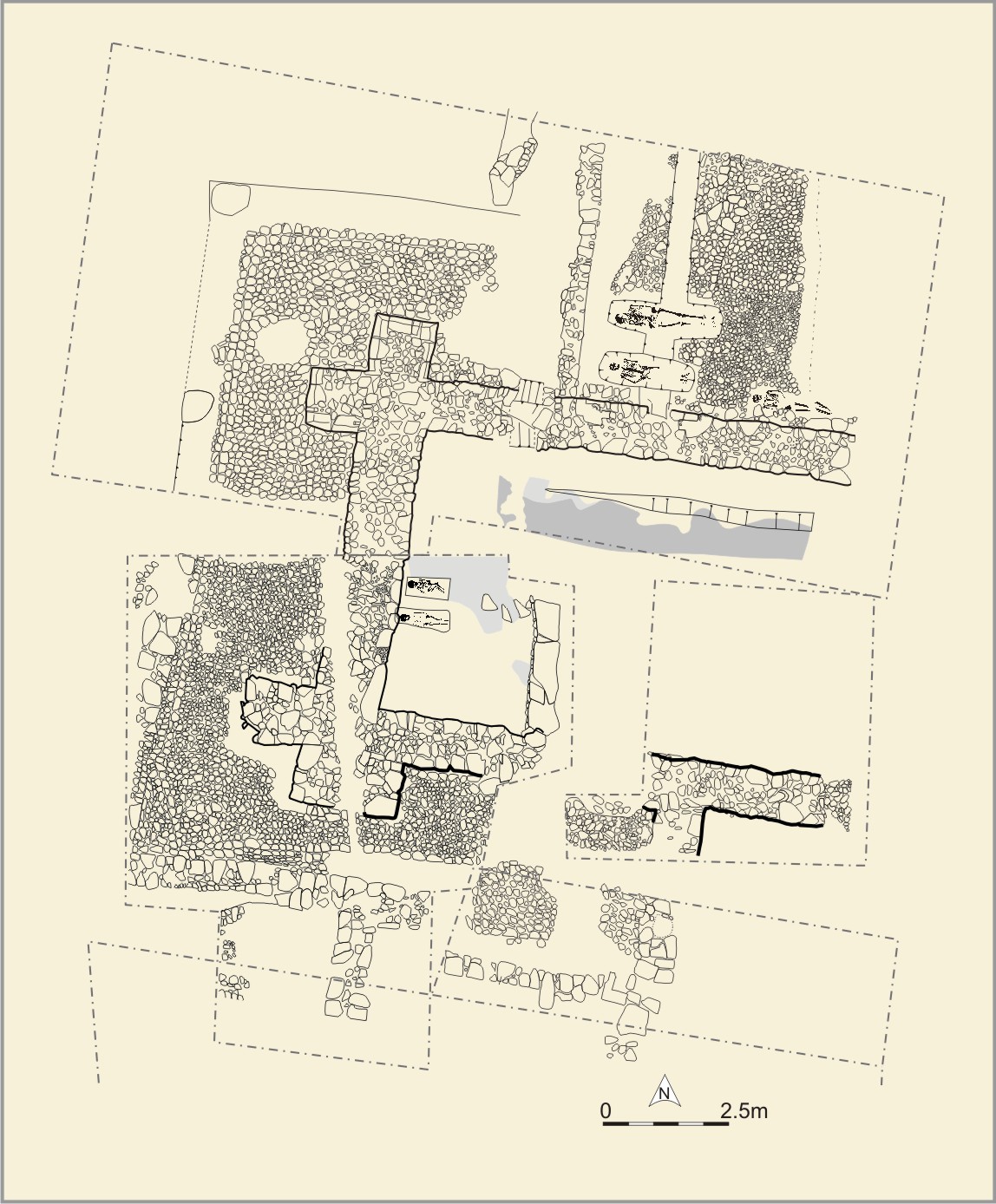
During this phase a mortar floor (incorporating layers A523 (which incorporated A531, A527, A477 and J153; see plan) was laid within the church. There was no evidence that this had been a bedding for a tile floor. Finds discarded on these floors included a Scottish billon penny of James IV dated to post-1496 but probably lost between 1497 and 1505 [18], a copper alloy wire fragment [895], pin [899].
The construction of a north-south wall JCU may have taken place in this phase. During the construction of JCU a number of burials were disturbed and the limb bones re-buried with some care in layer J168.

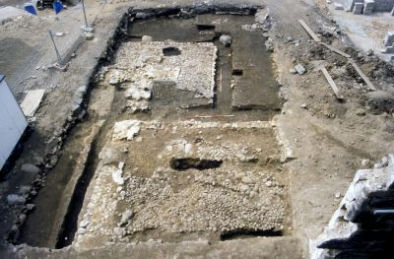
To the north of the church, two clay bonded stone boundary walls AKI [Photo 0405] and AKL were constructed. Their foundation trenches contained fragments of floor and roof tile suggesting that a building was being demolished or repaired in the area. It is possible that work was taking place on the church building to incorporate this new structure. These walls enclosed a courtyard which was covered with small, randomly-spread pebbles, AJS [Photo 0330] and AKJ. The surface was rough but included cobbled channels [Photo 0460] to allow water to drain away from the church. A copper alloy pin [902] had been discarded on the surface of this courtyard.
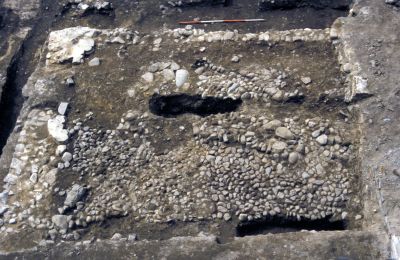

Around the north-west, west and south-west of the church, a neatly cobbled surface (AJV [Photo 0548], AGM [Photo 0082] and JCE [Photo 0549]) was laid. This was constructed of larger water-washed cobbles, set in grey clay. The surface sloped away from the church in all directions and a channel was constructed around its periphery. Water drained into the channel and through a duct (JCJ) and away from the area.

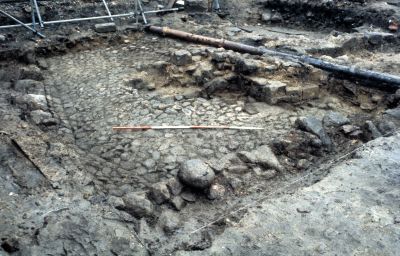

Around the edge of this cobbled surface, a clay-bonded stone wall JCF [Photo 0541] and JCG) was constructed. Around the north-west corner of this courtyard, the wall survived only as a robbed wall foundation trench (AKM/AKB) with all the small stones having been robbed, leaving only a huge boulder at the north-west corner of the courtyard [Photo 0167]. The area 'outside' this courtyard appears to have continued in use as a garden area.
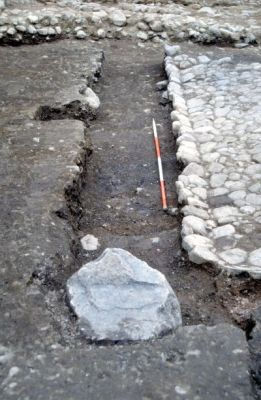
A linear arrangement of stones, ALF, north of the cobbled area, had no foundation trench and was sitting on a layer of garden soil. It may have been a small section of wall but did not survive well enough to interpret.


North of the church, at about this time, two burials took place, both immediately outside what had been the north door of the church. SK 232 (AKP) [Photo 0327] was a very deep coffin burial [Photo 0154] of an early middle-aged individual, possibly female. Thirty-six iron nails [871], marked on the photograph using white tags, with traces of wood adhering were recovered from around the burial and within the burial was a copper alloy boss mount [873].
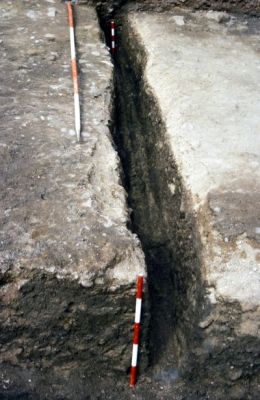
There was no evidence of a coffin for burial of SK 230 (AMP) [2230] of a middle-aged adult male. The burial had been disturbed by the removal of lead pipe from a trench, AKR [Photo 0447], north of the friary church. It is possible that the pipe was rediscovered during the burial of one of these individuals and subsequently removed. The robber trench for the lead pipe contained a copper alloy pin [877].
The burial of a late middle-aged female (SK 236 (ANF) [2236 ]) took place north of the church.
Burials of two children SK 18 and SK 19 took place within the church. During the interment of SK 18, human bones were found and reburied in a discrete pile near the feet of the burial [Photo 0543].
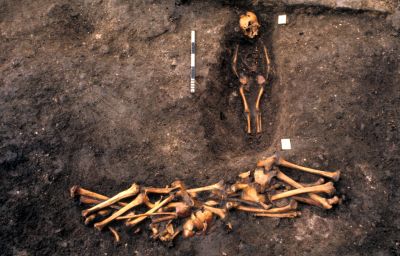
The most northerly portions of the Phase 4 lead pipe were removed in this phase. It appears that the pipe was discovered during the digging of graves for burials SK 232 (AKP) and SK 230 (AMP) and a robber trench (AKR) [Photo 0258] was identified.
Structure 6 remained in use during this phase. New earthen floor surfaces were laid in each of the rooms and in the kitchen and a cobbled surface was laid around the existing hearth and against the east wall.
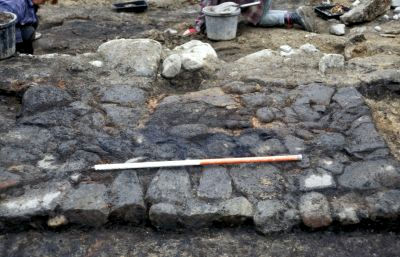
Water-washed granite cobbles, AFM and AFN, were laid in the corner of the kitchen surrounding Phase 5b hearth AGG [Photo 0286], and covered approximately one-third of the floor area of this room. They covered drain HC, which had gone out of use by this phase. There was no evidence of what replaced it. Another area of cobbles, AFG, was laid against the east wall of this room. There was no evidence that they had ever covered more of the room, and this regular area may have been the base for a piece of furniture.
Structure 5A continued in use through Phase 6.
Internet Archaeology is an open access journal based in the Department of Archaeology, University of York. Except where otherwise noted, content from this work may be used under the terms of the Creative Commons Attribution 3.0 (CC BY) Unported licence, which permits unrestricted use, distribution, and reproduction in any medium, provided that attribution to the author(s), the title of the work, the Internet Archaeology journal and the relevant URL/DOI are given.
Terms and Conditions | Legal Statements | Privacy Policy | Cookies Policy | Citing Internet Archaeology
Internet Archaeology content is preserved for the long term with the Archaeology Data Service. Help sustain and support open access publication by donating to our Open Access Archaeology Fund.